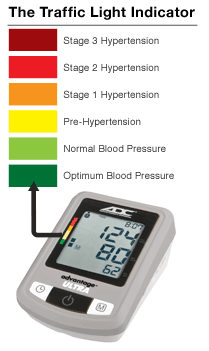- Products
- New Products
- Featured Products
- Color and Print Themes
- Blood Pressure Measurement
- NIBP / Vital Sign Monitors
- Digital Aneroid Sphygmomanometers
- Palm Aneroid Sphygmomanometers
- Pocket Aneroid Sphygmomanometers
- Pro's Combo Sphygmomanometers
- Multicuff Sphygmomanometers
- Clock Aneroid Sphygmomanometers
- Mercury Sphygmomanometers
- Home Blood Pressure Measurement
- Adcuff +
- Gauges
- Bulb & Valves
- Disposable Cuffs
- Reusable Cuffs & Bladders
- Sphygmomanometer Accessories
- Sphygmomanometer Parts
- Caseware
- CPR / Airway
- EENT
- Instruments & Accessories
- Laryngoscopes
- Penlights
- Pulse Oximeters
- Stethoscopes
- Thermometry
- Vital Signs Monitors
- Solutions
- About ADC
- Learning Center
- Support
- Blog
- Contact
8 Things to Look for in a Home BP Monitor

Written By:
Cindy Maley / Product Manager
Posted On:
August 14, 2014
Study after study has demonstrated the value of regularly monitoring your blood pressure at home. The 2013 WHO paper on hypertension urges home measurement. Now that you’re convinced that you need to measure your blood pressure at home, how do you go about selecting an instrument?
There are literally dozens of brands and hundreds of models of home BP monitors from which to choose. So how do you choose the one that’s right for you? We’ve listed below what we feel are the 8 MOST important things to look for in your next home BP monitor.
- As we’ve written many times before, first and foremost, look at the company behind the brand. Make sure the model you choose is from a manufacturer with a strong track record in this industry. So many BP monitors are sold by importers of consumer products with absolutely no expertise in blood pressure or BP measurement technology.
- Look for independent certification from, or compliance with, a respected agency like the British Hypertension Society. Quality instruments will hold a strong BHS rating such as B or better. Preferably an A or even AA.
- Look for a unit that includes irregular heartbeat detection. This feature will ensure greater accuracy on patients with an irregular heartbeat — a condition that often goes undetected, but can confuse the software of BP monitors without this capability.
- Unless portability is a major concern, choose a unit that measures at the upper arm. In theory upper arm and wrist models are of comparable accuracy, but in practice you’re likely to experience greater consistency in readings obtained on an upper arm unit. Wrist models are recommended for those with arms too large to fit properly in an upper arm cuff, or for people who travel regularly and need portability.
- If you can afford it, choose a fully automatic unit (with automatic inflation). The more you leave to the instrument itself, the more consistent the measurement results will likely be.
-
If you can afford it, choose a unit that takes up to three successive measurements and averages the readings. This tends to smooth the measurement results and makes the readings more meaningful. It also reduces the occasional inconsistencies that often lead to confusion and post purchase disappointment.

- If you can afford it, choose a unit that links to PC software to make tracking and trending easier to observe. It is universally agreed that individual readings are of less value than repeated measurements taken over time and the easiest way to track and observe is with the help of specialized software. Some models do this through a smart phone app — others link to a traditional PC. Others still, are compatible with Microsoft® HealthVault™, allowing you to manage your BP records online. It doesn’t really matter which technology is used, just that tracking be available.
- Make sure the unit is backed by a reasonable warranty. We suggest at least 2 years. Beyond 5 is of limited value as emerging new technologies will likely make your purchase obsolete long before it fails.
There are a lot of other features available all of which can be helpful, but we think are less essential. These include:
- Extensive memories with date and time stamps: nice to have, but in all likelihood, you will want to manually log the readings and bring the record to your caregiver for review. And if your unit has computerized tracking (PC link or smart phone app), you really don’t need all those memories. If you do select one with memories, make sure they have a date/time stamp. Memories without a date/time stamp are of limited value.
-
A/C adapter: a nice feature to have if you plan to use the device regularly and keep the instrument plugged in and on your desktop. If you plan to put it in a drawer after each reading, it’s of little value.

- Traffic Light System: Evaluates the hypertension risk in accordance with WHO standards. Nice, but not absolutely necessary. Better left to your healthcare provider to decide on the meaning of your readings and the course of treatment, if any required.
- Morning Hypertension Indicator: A new feature offered by some manufacturers that filters stored readings by time of day. Nice, but not essential if you use tracking software.
- Ecclempsia Measurement: Hypertension during pregnancy. If you’re pregnant, this is an important feature, but of limited value to anyone else.
- Extended Range cuff: Will fit a larger range of arms. Important if more than one in your household plans to take their BP with the same instrument. Otherwise, just make sure the included cuff fits YOU. Most instruments indicate the arm circumference range on the outer box. Look for specific ranges (typically in cm), not simply generic size names (i.e., adult).
ADC is a leading manufacturer of professional sphygmomanometers. We’ve applied our three decades of blood pressure measurement expertise to our comprehensive line of home BP monitors. ADC Homecare models are sold primarily through home healthcare and medical supply retailers. With 9 models ranging from basic manual instruments to fully automatic monitors with PC Link, we’re sure to have the instrument that’s right for you.

.jpg) Advantage™ Ultra Home BP Monitor
Advantage™ Ultra Home BP Monitor.jpg) Advantage™ Plus Home BP Monitor
Advantage™ Plus Home BP Monitor Advantage™ 6021N Home BP Monitor
Advantage™ 6021N Home BP Monitor.jpg) Advantage™ 6012 Semi-Automatic Monitor
Advantage™ 6012 Semi-Automatic Monitor.jpg) Advantage™ Ultra Wrist Monitor
Advantage™ Ultra Wrist Monitor.jpg) Advantage™ 6015N Wrist Monitor
Advantage™ 6015N Wrist Monitor
 6005 Manual Blood Pressure Kit
6005 Manual Blood Pressure Kit